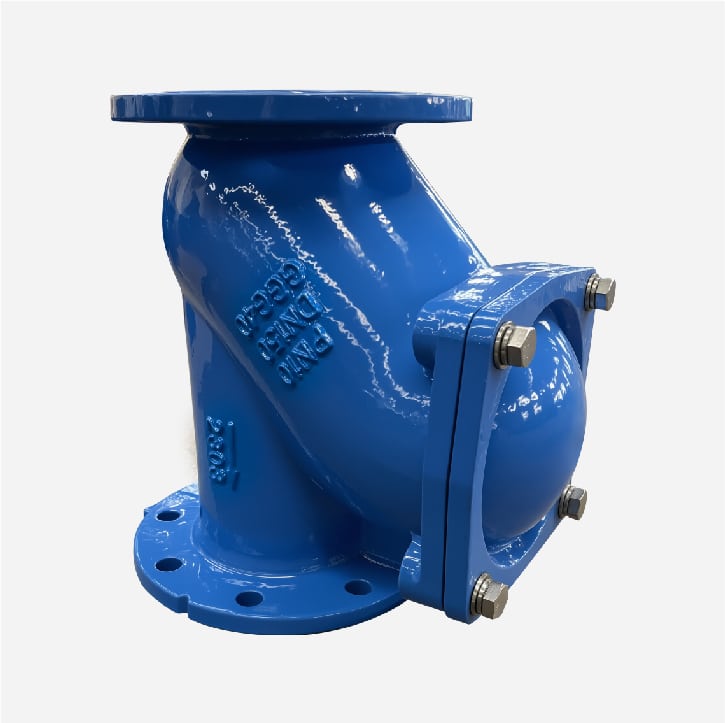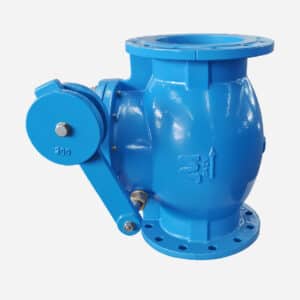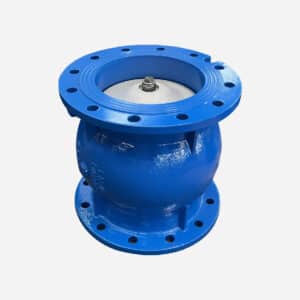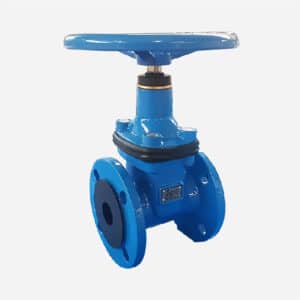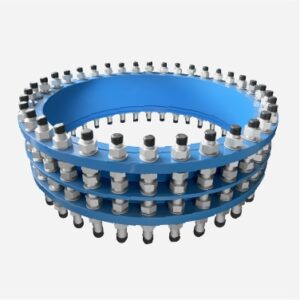Ball Check Valve is an automatic valve that uses the movement of a ball to control the one-way flow of fluid and prevent back flow. Ball check valves use changes in fluid pressure to automatically control the position of the ball, thereby controlling the direction of fluid flow.
As a ball check valve manufacturer from china, Judberd can supply below ball check valves. Judberd ball check valve feature is as below
The ball rotates in the pipe and thus self-cleaned
Full bore design to assure low head loss
Good low back pressure sealing performance, 0.2 M pa can be sealed
Our dimension is from DN50 to DN600 for flange ends, and from 1″ to 3″ for thread ends.
Valve flap surface lined with rubber, its ball size accuracy and surface roughness can be controlled by rubber-lined moulds, the ball processing accuracy requirements are reduced and can be reused, thus reducing the cost of the valve ball
The surface of the metal ball rubber will be elastic deformation, can absorb vibration and vibration damping, and play a certain buffer role.
The ball adopts a hollow structure, which is light in weight and reduces the impact of the valve ball on the valve seat when it is closed.
The inner diameter of the ball track is designed to be larger than the corresponding flange pipe diameter, increasing the circulation cross-section, the medium resistance is small, the pressure loss is reduced.
Ball check valve for water
Flange ends
Design Standard: BS EN1074-3/BS EN 12334/AWWA C508
BALL CHECK VALVE FOR WATER
Flange ends
Design Standard: BS EN1074-3/BS EN 12334/AWWA C508
VIDEO
Ball Check Valve In Workshop
Ball Check Valve in Workshop
Pressure Test for Ball Check Valve
Back Pressure Sealing Performance Test
WORKING PRINCIPLE
Ball check valve is an automatic valve that controls the one-way flow of fluid and prevents backflow by the movement of a ball.
Here is how a ball check valve works and how it operates:
HOW BALL CHECK VALVE WORKS
A ball check valve uses changes in fluid pressure to automatically control the location of the ball and thus control the direction of fluid flow.
The main principles of how they work are as follows:
FORWARD FLOW
_
When fluid flows in the desired forward direction, fluid pressure pushes the ball away from the seat, opening the valve.The ball is pushed to the other end of the valve body, creating a channel for the fluid to flow freely.
The kinetic energy and pressure of the fluid overcome gravity and any slight spring forces that might exist to keep the ball in the open position.
BACKFLOW
_
When fluid tries to flow back, the reverse pressure of the fluid and gravity work together to push the ball back onto the seat.
The ball fits snugly against the seat, preventing fluid from flowing back.Because the ball makes a large contact area with the seat, it can create a good seal to ensure no fluid flows back.
HOW THE BALL MOVES
The movement of the ball depends mainly on fluid pressure and gravity:
FORWARD FLOW
_
Fluid pressure from the entrance of the valve pushes the ball toward the exit as the fluid flows forward.After the ball is pushed away, the fluid creates a flow channel around the ball for the fluid to flow through.
BACKFLOW
_
When the fluid pressure reverses, the ball quickly moves back to the seat position under the reverse fluid pressure and gravity.The ball contacts the seat, creates a seal, and prevents the fluid from flowing back.
HOW BACKFLOW IS PREVENTED
The key to preventing backflow with a ball check valve is the seal where the ball contacts the seat
SEAL
_
The seat is typically designed as a cone or arc that matches the shape of the ball so the ball can fit snugly against the seat.This design ensures that the ball, when pushed by the reverse pressure, quickly and tightly returns to the seat to create an effective seal to prevent fluid from flowing back.
ADAPTABILITY
_
The movement of the ball inside the valve is automatic and adaptive, requiring no external control.The changing fluid pressure directly controls the position of the ball to achieve one-way control of the fluid and prevent backflow.

APPLICATION
Ball check valves are a common type of check valve that uses a ball to control the one-way flow of fluid through a passage.
The structure and design of ball check valves make them ideal for specific applications.
Here is a detailed explanation of the applications and suitability of ball check valves:
STRUCTURE AND DESIGN
SIMPLE PREPARATION
_
Ball check valves typically consist of a ball, seat, and body. The ball moves freely within the passage. When fluid flows from the inlet to the outlet, the fluid pressure pushes the ball away from the seat, allowing the fluid to pass. When the fluid flows in the opposite direction, the ball is pushed against the seat, preventing the backflow.
SELF-CLEANING CAPABILITY
_
The ball rolls freely in the valve chamber and can automatically clean impurities and deposits from the chamber, reducing the risk of blockage.
GOOD SEALING PERFORMANCE
_
The large contact area between the ball and the seat provides good sealing performance, making it particularly suitable for applications requiring tight sealing.
FAST RESPONSE
_
Because the ball has a small mass, it can quickly respond to changes in fluid pressure, providing timely check functions.
APPLICATIONS
SEWAGE TREATMENT AND DRAINAGE SYSTEMS
Ball check valves are widely used in sewage treatment plants and drainage systems. Their self-cleaning capability and good sealing performance allow them to handle fluids containing solid particles and impurities, reducing blockages and maintenance frequency.
CHEMICAL AND FOOD INDUSTRY
These industries often handle high viscosity liquids. The design of ball check valves can effectively prevent fluid backflow and are not easily blocked by viscous liquids.
PUMP SYSTEMS
In water pumps and other pump systems, ball check valves are used to prevent fluid flow when the pump is stopped, protecting the pump and piping system. Its fast response characteristics ensure system safety and reliability.
COMPARISON WITH OTHER CHECK VALVES
SWING CHECK VALVE
● Structure
Controls fluid flow using hinged valve discs.
● Advantages
Suitable for large diameters and low-speed fluids.
● Disadvantages
Slow response, inferior sealing performance to ball check valves.
● Applications
Suitable for large diameter pipelines and low-speed flow.
SILENT CHECK VALVE
● Structure
Usually a spring-loaded piston or disk to prevent water hammer.
● Advantages
Quiet operation, prevents water hammer.
● Disadvantages
Complex structure, high cost.
● Applications
Suitable for high-pressure systems that require low noise and prevent water hammer.
LIFT CHECK VALVE
● Structure
The valve flap rises when the fluid passes, and the valve flap falls to close when the fluid flows in the opposite direction.
● Advantages
Suitable for high-pressure and high-temperature environments.
● Disadvantages
Sensitive to impurities in the fluid, prone to clogging.
● Applications
Suitable for high-pressure boilers and steam systems.
REASONS FOR SUITABILITY
Ball check valves are ideal for systems that handle fluids with solid particles or viscous liquids due to their self-cleaning, good sealing, and fast response characteristics.
In contrast, swing check valves are suitable for large-diameter, low-speed fluids. Silent check valves are suitable for high-pressure systems that prevent water hammer, and lift check valves are suitable for high-pressure, high-temperature environments.
When selecting the appropriate check valve type, you should consider the specific requirements of the application and the characteristics of the fluid.
INSTALLATION
The steps to install a ball check valve are as follows:
SIMPLE STRUCTURE
_
Ensure that there is no residue or dirt in the pipeline.Check the ball check valve for damage, especially the sealing ring and ball.
DETERMINE THE INSTALLATION LOCATION
_
Install horizontally or vertically, but note that ball check valves generally only work horizontally. Make sure that the flow direction of the fluid is consistent with the arrow on the valve body.
INSTALL THE FLANGE
_
If it is a flanged ball check valve, align the flanges at both ends of the valve with the flanges on the pipe and secure them with bolts. Make sure the gasket at the flange connection is intact and tighten the bolts diagonally and evenly, gradually.
INSTALL THE THREADED CONNECTION
_
If it is a threaded ball check valve, apply a sufficient amount of sealant or wrap the sealing tape on the threads of the pipe, then rotate the valve in a clockwise direction until it is tightened.
CHECK THE SEALING
_
After installation, perform a sealing test. Slowly open the valve in the pipeline system and let the fluid flow through the ball check valve to check for any leaks. If there are leaks, readjust or replace the seals.
MAINTENANCE AND CARE
_
Regularly check the operation of the ball check valve to ensure it is working properly. Pay particular attention to cleaning impurities inside the valve to prevent blockages and wear.
Feel free to contact Judberd if you have any questions or need further technical support.
COMMON PROBLEM FOR BALL CHECK VALVE
Common problems with ball check valves in use. Here is an analysis and solution to these problems:
LEAKAGE
_
● Reason
The valve seat or sealing ring is worn or damaged.
Impurities or dirt in the valve cause poor sealing.
● Solution
Inspect and replace damaged valve seats or sealing rings.
Regularly clean the inside of the valve to ensure that there are no impurities.
THE VALVE CANNOT BE FULLY CLOSED
_
● Reason
The ball is stuck or worn.
Foreign matter in the valve obstructs the movement of the ball.
● Solution
Check the condition of the ball and replace it if necessary.
Clean the inside of the valve to remove all foreign matter.
THE VALVE IS NOT SENSITIVE
_
● Reason
There is sediment on the ball or valve seat, causing it to move poorly.
The valve is installed incorrectly, causing the ball to not move properly.
● Solution
Regularly clean the ball and valve seat to ensure a smooth and unobstructed surface.
Check the installation direction to ensure that it is installed according to the arrow on the valve body.
VALVE VIBRATION OR NOISE
_
● Reason
The fluid flow rate is too high, causing vibration.
The ball moves unstably in the valve body, causing noise.
● Solution
Adjust the system flow to reduce the fluid flow rate.
Check the fit of the ball and the valve body to ensure the ball moves smoothly.
THE VALVE HAS A SHORT LIFE
_
● Reason
The valve material selected is not suitable for the working environment, such as the fluid being corrosive or the temperature being too high.
The valve is used too frequently, exceeding its design life.
● Solution
Select a ball check valve made of suitable material for the working environment, such as stainless steel or high-temperature resistant materials.
According to the usage requirements, arrange maintenance and replacement cycles reasonably.
Through the analysis and solutions above, common problems with ball check valves in use can be effectively resolved,
extending its service life and ensuring the normal operation of the system.
Feel free to contact Judberd if you have any other technical questions.



